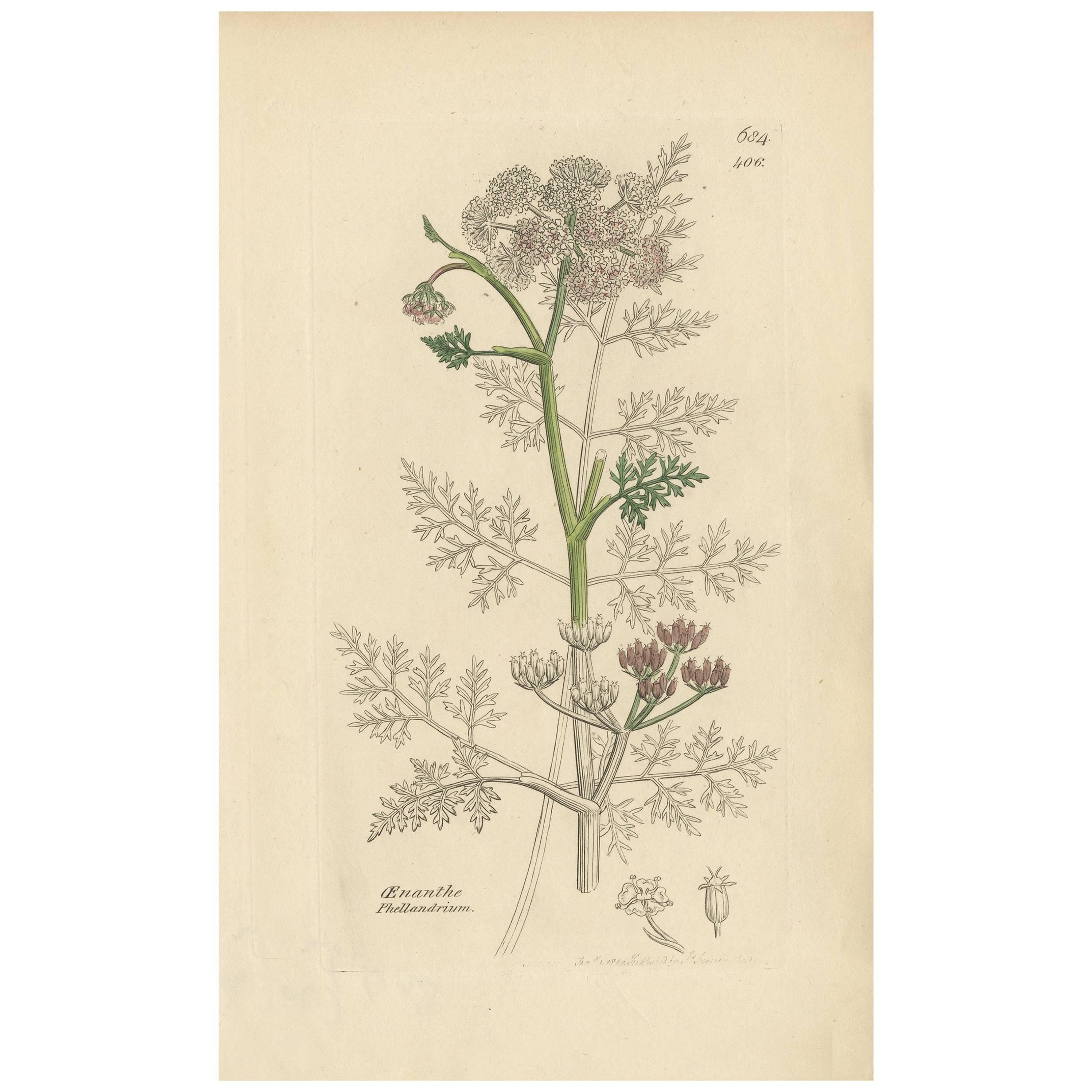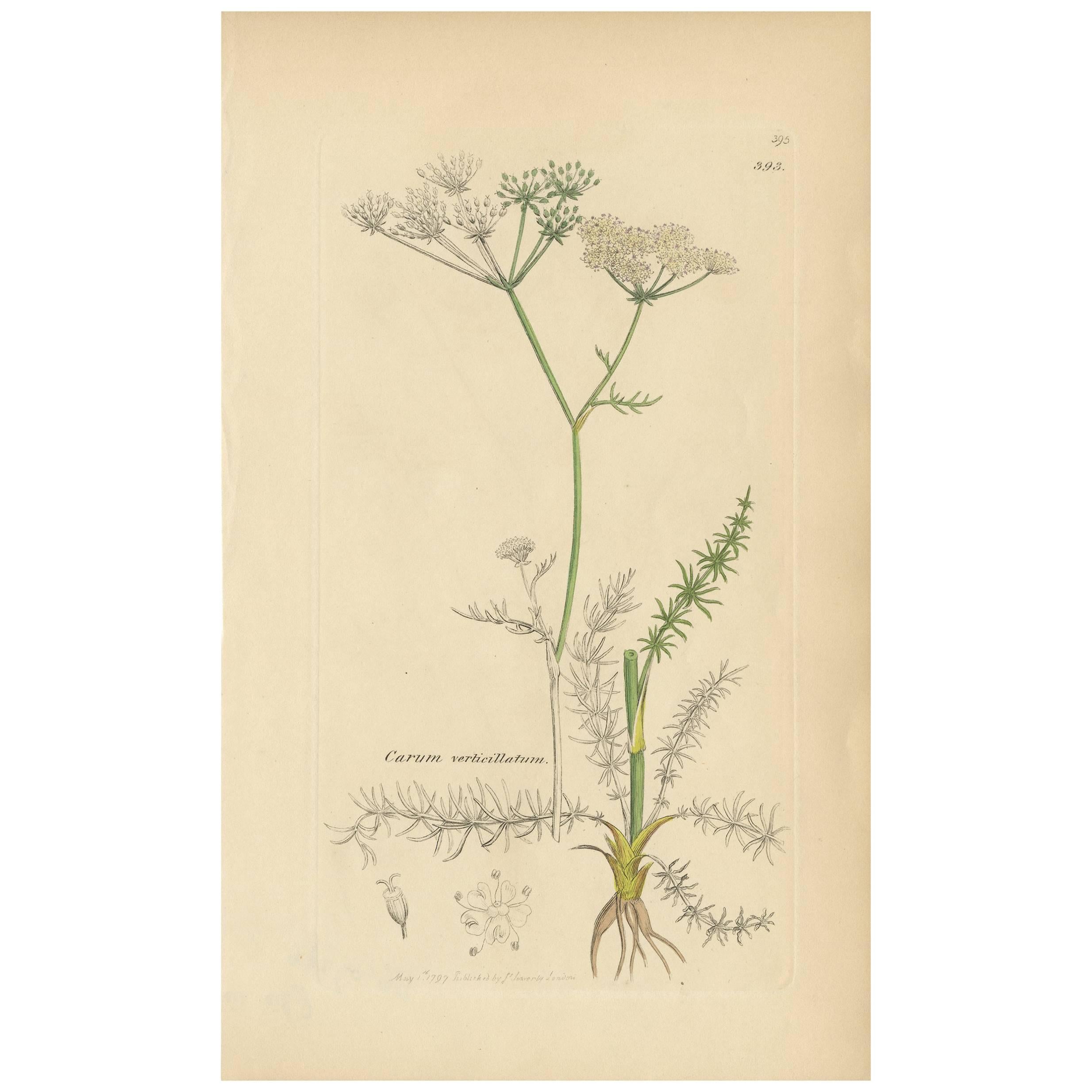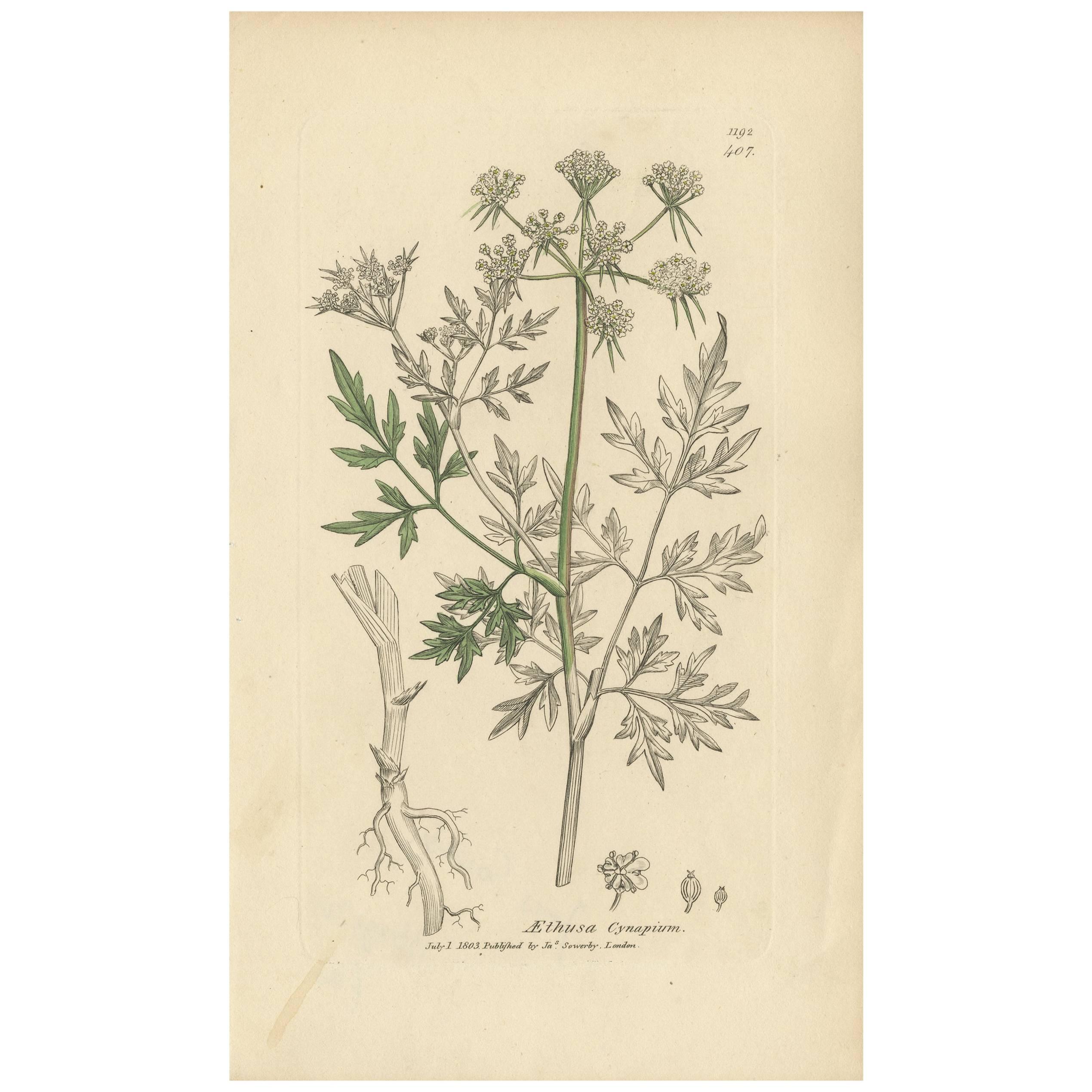Items Similar to "Faux Bamboo" Frame With Six English Botanical Prints By James Sowerby
Want more images or videos?
Request additional images or videos from the seller
1 of 19
"Faux Bamboo" Frame With Six English Botanical Prints By James Sowerby
About the Item
We kindly suggest that you read the entire description, as with it we try to give you detailed technical and historical information to ensure the authenticity of our objects.
The frame encloses six prints and is very special and unusual; it was made in recent times by an old Master cabinetmaker who has his workshop in the "coolest" neighborhood of Florence: San Frediano, known for the fascinating and unique "workshops" of artisans who produce with their own hands; the Master used a wood washed and carved to resemble bamboo, practically the workmanship known as "faux bamboo." With this technique, the appearance of bamboo is created by using hard, durable woods such as maple or oak; carving tools are used to achieve the desired effect and then a varnish is used to enhance the final appearance of the "faux bamboo." The faux bamboo technique has a history dating back several centuries. It gained popularity during the 18th and 19th centuries in Europe and America, a period known for its fascination with exotic and oriental design influences. The technique was particularly associated with the Chinoiserie style, an artistic movement that drew inspiration from Chinese art and design. During this period, bamboo furniture and decorative objects from Asia became highly sought after, but the actual bamboo material was not always readily available. To meet the demand, artisans developed the technique of faux bamboo as a way to replicate the appearance of bamboo using more accessible materials such as wood and metal. The use of faux bamboo in furniture and design continued into the Victorian era, where it was often incorporated into objects such as chairs, tables, and cabinets. The prints were printed in London between 1806 and 1833 using the technique of "chromolithography" ,from the Greek crhomo (color), lithos (stone) and graphia(draw), a technique obtained by superimposing images of different colors engraved on different stones, one for each color; with this process it was possible to imitate the colors of tempera paintings, obtaining very bright shades and tones. The illustrated plants, whose name is written on the page of each plant, are perennials with underground buds and grow mainly in a type of terrestrial environment characterized by a particular vegetation and climate; the distribution area of these species is Macaronesia; the name comes from the Greek expression "makaron nêsoi" and means "Islands of the Blessed" ; in ancient times it was thought that the gods had decided to give a special gift to the best men, giving them so much overflowing wonder and the chance to live here. They include the Azores, Cape Verde, Porto Santo, Canaries, Desertas, Selvagge and Madeira. The prints are the work of James Sowerby (1757-1822) an English naturalist and illustrator, best known for his work in the field of botany. James Sowerby was born on March 21, 1757, in Lambeth, London, England. He came from a family of artists and naturalists, and his early interest in the arts and sciences influenced his career and led him to become a prominent figure in the scientific community of his time. Sowerby came to be appreciated for his meticulous and detailed illustrations of plants and minerals. James Sowerby had a business in London related to his work. He ran a natural history store and a print warehouse. In 1790 he opened a store at No. 2 Mead Place, Lambeth, where he not only sold his illustrated publications but also specimens, prints, and other items related to natural history. The store became a meeting place for scientists, naturalists, and specimen collectors and was a focal point for the dissemination of scientific knowledge and illustrations in the late 18th and early 19th centuries. Sowerby's store, which also housed the production of his publications, played a crucial role in the distribution of his works, including those on botany and mineralogy, becoming a center for the creation and sale of scientific materials. James Sowerby's legacy lies in his substantial contribution to the documentation and illustration of the natural world. His representations of plants and minerals continue to be appreciated by scientists and researchers. The Sowerby family, including his children and grandchildren, continued the tradition of scientific illustration and contributed significantly to the fields of botany and mineralogy. The frame and prints are in good condition. Measurements Width cm.67, height cm.65, depth cm.4. Measurements of each print cm.11 x cm.21. For all our shipments we use special packaging materials (custom-made wooden crates, styrofoam, etc.
- Dimensions:Height: 26.38 in (67 cm)Width: 25.6 in (65 cm)Depth: 1.58 in (4 cm)
- Style:Chinoiserie (Of the Period)
- Materials and Techniques:
- Place of Origin:
- Period:
- Date of Manufacture:1806-1833
- Condition:Wear consistent with age and use. The frame and prints are in good condition.
- Seller Location:Prato, IT
- Reference Number:
About the Seller
5.0
Platinum Seller
These expertly vetted sellers are 1stDibs' most experienced sellers and are rated highest by our customers.
Established in 1977
1stDibs seller since 2019
234 sales on 1stDibs
Typical response time: 2 hours
- ShippingRetrieving quote...Ships From: PRATO, Italy
- Return PolicyA return for this item may be initiated within 14 days of delivery.
More From This SellerView All
- Mirror Frame With English Chromolithographic Prints With FlowersLocated in Prato, TuscanyWe kindly suggest that you read the entire description, as with it we try to give you detailed technical and historical information to guarantee the authenticity of our objects. The ...Category
Early 20th Century British Late Victorian Prints
MaterialsMirror, Wood, Paper
- Pair of English Color Prints with Golden FramesBy John Raphael SmithLocated in Prato, TuscanyWe kindly suggest you read the whole description, because with it we try to give you detailed technical and historical information to guarantee the authenticity of our objects. Part...Category
Antique Late 18th Century British Neoclassical Prints
MaterialsPaper
- Simon Thomassin French Print " La Gloire De La France" Etched with Wooden FrameBy Simon ThomassinLocated in Prato, TuscanyWe kindly suggest you read the whole description, because with it we try to give you detailed technical and historical information to guarantee the authenticity of our objects. Beaut...Category
Antique 1720s French Neoclassical Prints
MaterialsWood, Paper
- Mirror Frame With Engraved Dutch Print Depicting Dukes Of Mirandola Coat Of ArmsLocated in Prato, TuscanyWe kindly suggest that you read the entire description, as with it we try to give you detailed technical and historical information to guarantee the authenticity of our objects. The ...Category
Antique Mid-17th Century Dutch Modern Prints
MaterialsWood, Paper
- Nargeol Adrien Pair Prints Painted Watercolor with Gilded FramesLocated in Prato, TuscanyWe kindly suggest you read the whole description, because with it we try to give you detailed technical and historical information to guarantee the authenticity of our objects. Pair of prints engraved by burin and painted in watercolor; both are a tribute to Cupid; the name Cupid - meaning desire, lust - was given by the Romans to the Greek god of love, actually called Eros. Alternatively, he was called just Love always by the Latins. As the son of Aphrodite, goddess of love, he, like his mother, was capable of any act, even deplorable. In the first print, which has been cut out and shaped, there are two young girls offering God a basket of fruit and a goblet of wine; in the second print a mature woman is about to be hit by Cupid's love arrow; both prints have been made with a beautiful burin engraving, then finished with delicate watercolors. The frames are handmade in gilded wood. The prints were made between 1850 and 1855 by Adrien Nargeol (see signature) a prolific and talented French engraver and were published in the "Journal des Demoiselles...Category
Antique Mid-19th Century French Napoleon III Prints
MaterialsWood, Paper
- Jean Baptiste Morret French Etching with Allegorical Subject Gilded Wood FrameLocated in Prato, TuscanyWe kindly suggest you read the whole description, because with it we try to give you detailed technical and historical information to guarantee the authenticity of our objects. Part...Category
Antique Early 19th Century French Other Prints
MaterialsWood, Paper
You May Also Like
- Set of Six Besler Framed BotanicalsLocated in Essex, MAAn assembly that I would consider selling separately. In gilt wood frames all in perfect shape. Prints in various conditions but overall good.From The Old Print Shop...Category
Antique Late 17th Century German Prints
MaterialsGiltwood, Paper
- Antique Botany Print 'Pimpinella Saxifraga' by J. Sowerby, 1797Located in Langweer, NLAntique print titled 'Pimpinella Saxifraga'. This print originates from Sowerby's English Botany, or colored figures of British plants, 1797.Category
Antique Late 18th Century Prints
MaterialsPaper
- Antique Botany Print 'Oenanthe Phellandrium' by J. Sowerby, 1840Located in Langweer, NLAntique print titled 'Oenanthe Phellandrium'. This print originates from Sowerby's English Botany, or colored figures of British Plants, 1840.Category
Antique Mid-19th Century Prints
MaterialsPaper
- Antique Botany Print 'Carum Verticillatum' by J. Sowerby, 1797Located in Langweer, NLAntique print titled 'Carum verticillatum'. This print originates from Sowerby's English Botany, or Coloured Figures of British Plants, 1797.Category
Antique Late 18th Century Prints
MaterialsPaper
- Antique Botany Print 'Lauro-Cerasus' by H. Sowerby, 1852Located in Langweer, NLHandcoloured lithograph by Henry Sowerby after an illustration by A.W. from Edward Hamilton's Flora Homeopathica, Bailliere, London, 1852.Category
Antique Mid-19th Century Prints
MaterialsPaper
- Antique Botany Print 'Aethusa Cynapium' by J. Sowerby, 1803Located in Langweer, NLAntique print titled 'Aethusa Cynapium'. This print originates from Sowerby's English Botany, or colored figures of British plants, 1803.Category
Antique Early 19th Century Prints
MaterialsPaper





